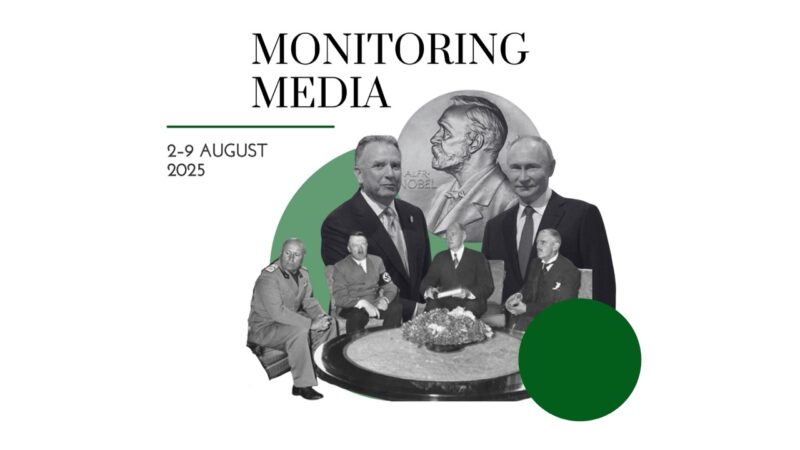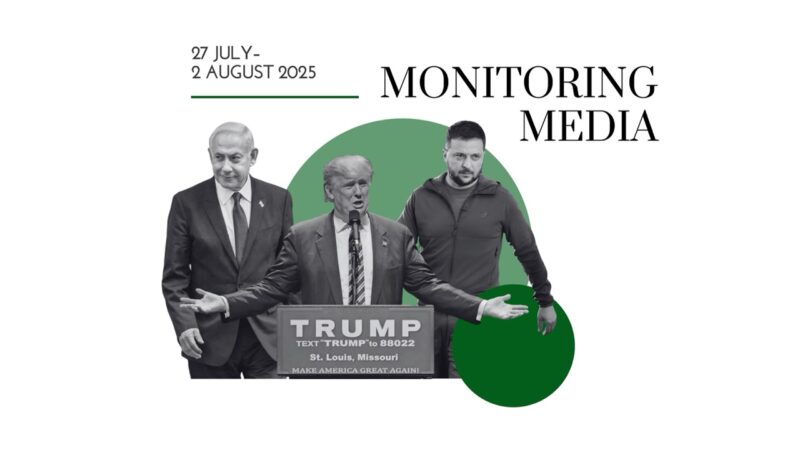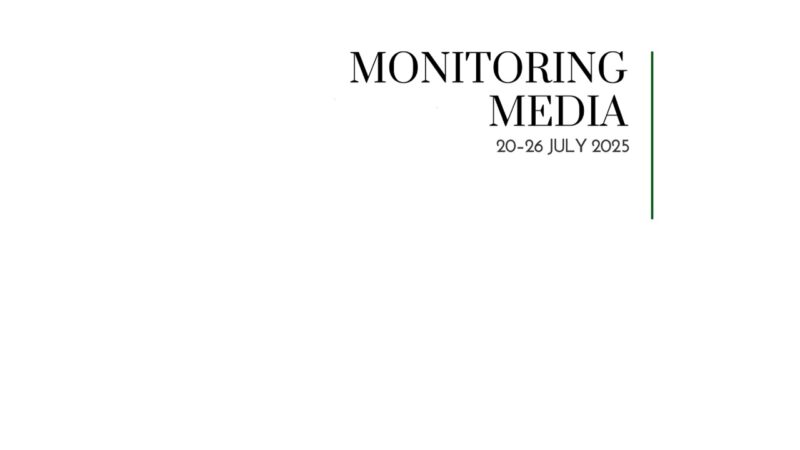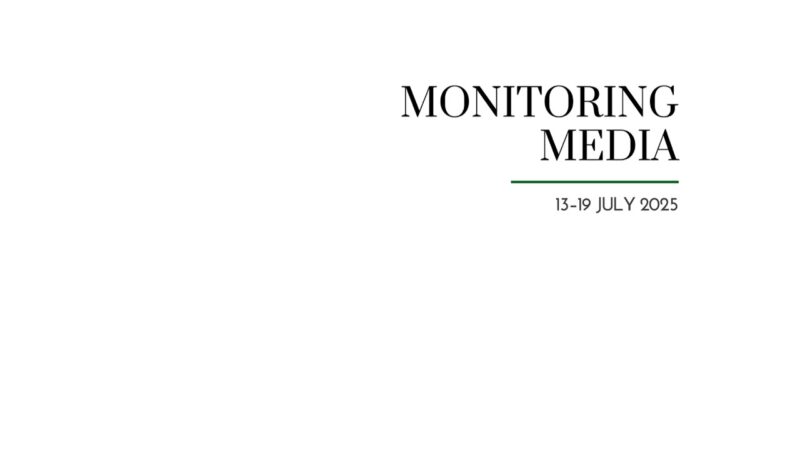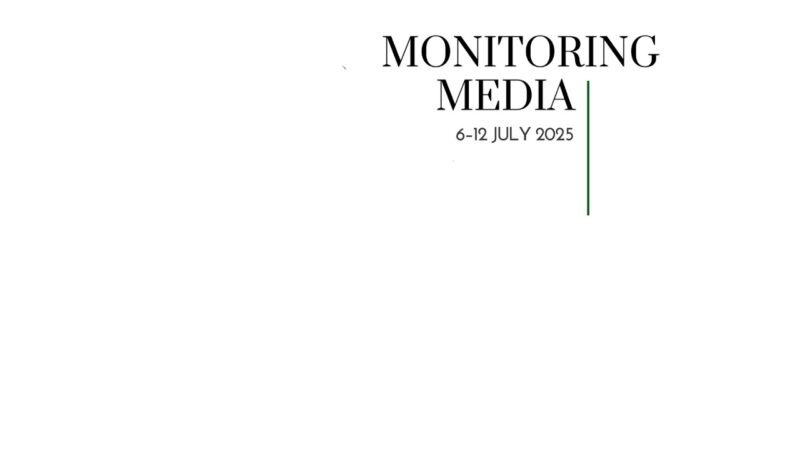Ukraine has rewritten the rules of war
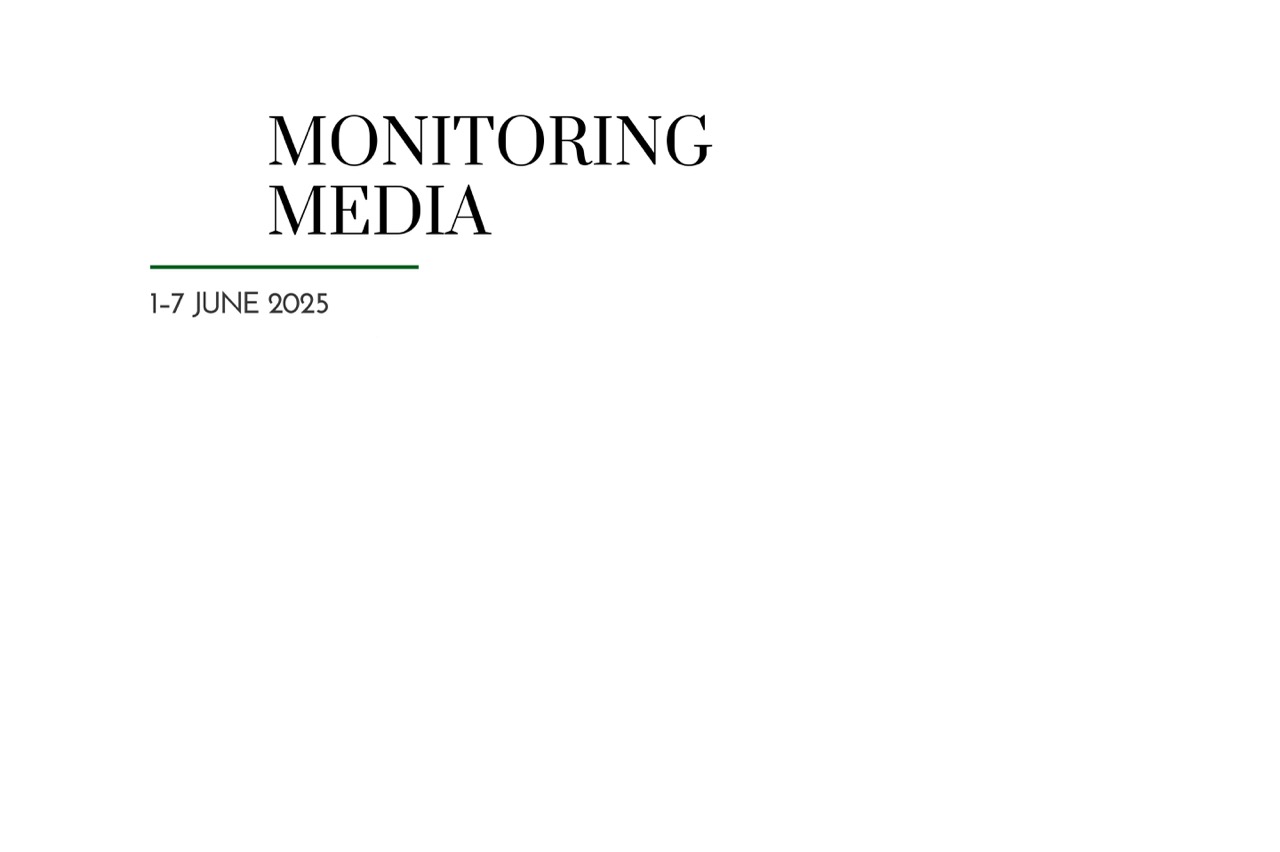
CIUS weekly report on North American media coverage of Ukrainian affairs, 1–7 June 2025
Seven publications (The Washington Post, Foreign Affairs, Foreign Policy, The Wall Street Journal, The Globe and Mail, Politico, and The New York Times) were selected to prepare this report on how Ukraine has been portrayed in the North American press during the past week. The sample was compiled based on their impact on public opinion as well as on their professional reputation, popularity among the readership, and topical relevance. These publications represent centrist viewpoints on the political spectrum.
This MMS report covers only the most-read and relevant articles about Ukraine, as ranked by the respective North American publications themselves in the past week. Its scope covers promoted articles on home pages and articles from special sections on Ukraine, with the hashtag #Ukraine, from the paper editions of the publications, and about Ukraine from opinion columns and editorials.
Featured topics
- The world and Ukraine: Ukraine has rewritten the rules of war; Ukraine’s drone strike exposes global military vulnerability.
- Russia at war: Washington must put pressure on Moscow; Kremlin has no strategy; Putin won’t let go of Ukraine, and the West must hold the line.
MMS summaries
Ukraine has rewritten the rules of war. Max Boot (Washington Post) claims that Ukraine’s attack on Russian bombers using drones has exposed vulnerabilities at air bases around the world. This attack is similar to the attack by the Imperial Japanese Navy on Pearl Harbor on 7 December 1941: “The analogy might make sense in that both attacks could signal the obsolescence of once-dominant weapons systems: battleships in 1941, manned aircraft today. Swarms of Ukrainian drones that probably cost tens of thousands of dollars to build in total might have inflicted $2 billion of damage on Russia’s most sophisticated aircraft.” To counter the threat of drone strikes, huge investments will be needed in anti-drone systems: “Money spent on conventional manned weapons systems increasingly looks to be as wasted as spending on the cavalry in the 1930s.” According to Boot, this attack will not be decisive in Russia’s war against Ukraine, just as the attack on Pearl Harbor was not a decisive blow to the US Navy: “But just as Pearl Harbor signaled that Japan would be a far more formidable foe than most Westerners had expected, Sunday’s attack shows, yet again, that the Ukrainians are proving far more resilient and adaptable fighters than anyone had anticipated before the start of Russia’s full-scale invasion more than three years ago.”
Washington must put pressure on Moscow. Edward Fishman (Foreign Affairs) believes that now is the best time for Congress to impose oil sanctions to force Russia to the negotiating table. The desire of Congress to tighten sanctions against an adversary against the will of the US president is nothing new. A similar situation occurred in 2009, when parliament, despite the wishes of President Barack Obama, imposed sanctions on Iran’s energy sector after negotiations failed: “Congress responded with wave after wave of sanctions, culminating in measures that devastated Iran’s oil revenues. European countries also stepped up and imposed an oil embargo. The combined pressure drove Iran’s economy into freefall, creating the conditions that ultimately brought Iran to the negotiating table.” In the author’s opinion, President Trump should learn a lesson from this situation: “If Trump is serious about ending the war in Ukraine, his administration should work with Graham and other hawks on Capitol Hill rather than oppose them.” According to Fishman, “The moment is ripe. Congress is losing patience. Europe is growing frustrated. And the global oil market is better positioned to absorb disruptions than it has been in years. The stars are aligning for Trump to get the cards he needs to change Putin’s calculus. The question is whether he’s ready to play them.”
The Kremlin has no strategy. Anastasia Edel (Foreign Policy) argues that President Vladimir Putin has no foreign policy strategy and is only interested in retaining power. The Kremlin’s steps to divide Western powers are focused on tactical destabilization rather than long-term influence: “Though these maneuvers have often yielded immediate gains, they have not made Russia an indispensable or trusted partner on the world stage. With Europe rearming amid Russia’s continued aggression, Putin’s opportunism has led him into a long-term strategic dead end.” During the Cold War, the international propaganda goals of Moscow largely mirrored domestic propaganda and were aimed at expanding its influence by supporting Communist movements abroad and discrediting capitalism as an “exploitative and morally bankrupt system.” Today, the main goal of the Kremlin’s international propaganda is to strengthen its regime. The Kremlin’s interference in Western affairs is not an end in itself, but a means of eliminating threats to its power: “After the 2014 EuroMaidan Revolution, Putin—steeped in the KGB worldview—saw Ukrainians’ desire to integrate with Europe not as democratic aspiration but as foreign subversion. This wasn’t just a geopolitical loss; that a sitting president of a post-Soviet state could be removed by popular revolt set a dangerous precedent.” In the author’s opinion, President Putin’s main driving force is not confidence but fear: “Foreign aggression is not realpolitik. It is a manifestation of and a shield for domestic fragility. Through this lens, Putin’s foreign policy can be understood as not just expansionism for its own sake, but insulation.” According to Edel, “Whether the final blow comes from a new U.S. administration, an ascendant China, or a resurgent Europe, Putin’s strategic game is already lost. The only question is who will recognize the limits of his position—and respond accordingly.”
Ukraine’s bold drone offensive proves it can outfight Russia. Bernard-Henri Lévy (Wall Street Journal) writes that Ukraine’s drone strike against Russian strategic aircraft marks a historic military achievement and a turning point in the war. Calling the 1 June operation “a brilliant technical performance,” the writer compares it to Israel’s 2024 annihilation of Hezbollah forces, noting its boldness and precision: “All 41 targets were carefully studied for months by Ukrainian intelligence, and they exploded simultaneously without civilian casualties.” The attack involved smuggling drones into Russia over eighteen months and concealing them in civilian trucks, showcasing both ingenuity and operational discipline. Levy positions this strike as the culmination of a series of Ukrainian victories—citing the sinking of the Moskva cruiser in the early days of the full-scale invasion, strikes on the Kerch Bridge, and drone raids on the Black Sea Fleet—as successive “humiliations” inflicted on Russia’s military and image. The author underscores that Ukraine is not only militarily resilient but technologically superior and morally grounded. The Ukrainian military is described as “the boldest, brightest, and best in Europe,” forged through hardship and innovation ranging from makeshift drones in forest huts to high-tech command centres in Pokrovsk and Sumy. In contrast, the Russian army is portrayed as hollow and reliant on foreign mercenaries, with its threats of nuclear escalation now blunted: “There was an army capable of calling [Putin’s] bluff—and it did.” Ukraine’s path to victory is now visible—whether on the battlefield or through diplomacy—as Russia’s losses mount and Ukraine proves it can “impose the terms of a just peace,” according to Levy.
Ukraine’s drone success highlights gaps in Canada’s defence strategy. Eliot Pence (Globe and Mail) argues that Canada urgently needs a modern equivalent of its historic Munitions Supply Program (MSP) to support large-scale domestic production of inexpensive drones, which have become essential tools in modern warfare. Drawing parallels to past wartime innovation, the author highlights how drones—particularly first-person view (FPV) models—have evolved into the new “ammunition” of contemporary conflict. Ukraine serves as the clearest example, producing up to 100,000 drones per month and aiming for 4.5 million annually. Ukraine has shown how scalable, low-cost UAVs can shape outcomes on the battlefield. “Drones—especially inexpensive ones—shouldn’t be treated like traditional aircraft. They’re closer to bullets than bombers: cheap, fast, disposable and essential for modern operations,” the author writes. While countries like China, Turkey, India, and the United States are rapidly scaling up their drone capabilities, Canada continues to rely on a defence procurement system designed for expensive, long-term acquisitions—poorly suited to the speed and scale required today. Pence proposes creating an MSP-style program specifically for drones, which would provide recurring funding, establish domestic production capacity, and streamline testing and training. Without such a move, Canada risks falling behind in a domain that is critical to both national security and allied defence commitments. “Canada once led the world in radar, communications, and aerospace. Let’s not miss the opportunity to lead in the drone era.”
Ukraine’s drone strike exposes global military vulnerability. W.J. Hennigan (New York Times) highlights how Ukraine’s Operation “Spider’s Web”—a daring drone assault deep inside Russian territory—has redefined modern warfare and exposed the vulnerabilities of even the most technologically advanced militaries. Using more than 100 explosive-laden quadcopter drones smuggled across the border, Ukraine struck four far-flung and widely dispersed Russian airfields and reportedly destroyed or damaged over forty strategic aircraft. President Volodymyr Zelensky called it Ukraine’s “longest-range operation,” and the author notes it “blindsided the Kremlin” while delivering a tactical blow with minimal cost. This attack not only pressures Russia militarily and diplomatically but also signals to the world how small, inexpensive drones can dismantle billion-dollar defence assets—and making it abundantly clear that such tactics could be replicated elsewhere. Hennigan warns that the US remains dangerously underprepared for this low-cost but high-impact threat. While General Gregory Guillot recently testified concerning three hundred fifty drone sightings over one hundred American military installations, such incidents are no longer minor nuisances. “Spider’s Web exposed the risk of not taking them seriously,” the author adds, stressing the urgent need to rethink US defences. Despite congressional efforts to invest in counter-drone technologies and the Pentagon’s billion-dollar Replicator initiative, the author criticizes the lack of urgency and transparency since Donald Trump took office. The US must stop prioritizing high-end systems at the expense of addressing threats from low-cost drones that “fly low to the ground and don’t always transmit their positions.” Ukraine’s success, the author argues, should serve as a wake-up call for American defence planners.
Putin won’t let go of Ukraine, and the West must hold the line. Nahal Toosi (Politico) argues that Russia’s President Putin remains unwavering in his goal to conquer all of Ukraine, despite increasing domestic and international pressures, and that Western policy should be focused not on changing his mind but on making that goal unattainable. Toosi notes that the West should let go of the illusion that Putin might one day abandon his ambitions, arguing instead that “you can’t make Putin walk away from Ukraine; you have to put Ukraine out of his reach.” This reframing is critical to understanding the current moment: while Ukraine is demonstrating remarkable resilience—most recently through a high-profile drone strike on Russian bombers—lasting deterrence will require sustained global efforts that go beyond sanctions or diplomatic warnings. Toosi also criticizes the Trump Administration, which he portrays as failing to grasp the psychological and ideological depth of Putin’s commitment to Ukraine. Although President Trump has recently adopted tougher rhetoric—calling Putin “absolutely CRAZY” and supporting new sanctions—his record of inconsistency undermines his credibility. Trump’s tendency to backtrack on hardline positions, as seen with tariffs and military aid, could signal weakness to Moscow. As one analyst puts it, the question is not whether Putin will abandon his goals, but whether “we can impose enough costs that he eventually says, ‘I cannot do this indefinitely.’” Meanwhile, Russia’s economy has undergone a structural shift toward wartime production, reducing the appeal of sanctions relief or Western investment as incentives for Putin. Even if Trump lifts sanctions, American businesses are expected to stay away from the Russian market due to ongoing risks and reputational concerns. The author notes that any ceasefire or negotiation should be approached with caution, as Putin is likely to use such opportunities to regroup. It is consistent pressure, rather than attempts to persuade, that is essential to countering Putin’s long-term ambitions.

